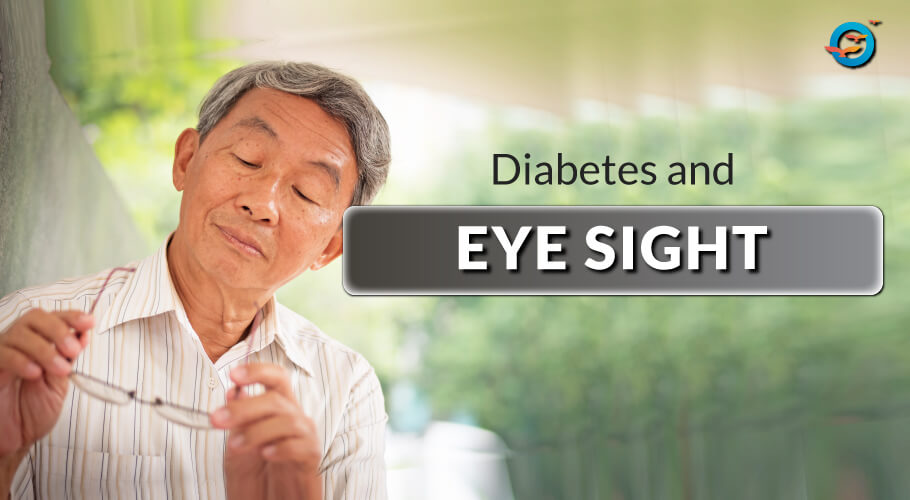Diabetic Retinopathy: All you need to know | FFD

What is Diabetic Retinopathy?
Diabetic Retinopathy is the primary cause of blindness in almost 70% of adults aged 30 to 70. But before you rush panic-stricken to your eye doctor, remember that bringing your blood sugar levels (BSL) under control can arrest and even reverse Diabetic Retinopathy.
The following are the most common diabetes and eye problems that one encounters.
1. Blurry Vision in Diabetics

High blood sugar reduces blood flow to the small capillaries of the eye, causing swelling and distortion of the eye lens. This results in blurry vision. Before changing your glasses, get your BSL checked.
If it is above the target range (100 mg/dl before meals/fasting and above 140 mg/dl one to two hours after a meal), your BSL is high and you could be suffering from pre-diabetes or even diabetes, without knowing it.
Blurry Vision Treatment
For Blurry Vision, treatment Consult your doctor and get on a proper diet-nutrition-fitness-destress routine. It takes 3 months or more for the lenses to settle back to their usual dimensions, so don’t give up if results are not instantaneous.
2. Eye Cataract

Eye Cataract are cloudy growths that can be seen on the internal lens of the eye. When cataracts form, they function just like dirty windows, compromising your ability to see clearly through them. When your lens of the eye is cloudy, it is harder for your eye to focus properly. Cataract symptoms include blurring of vision and glare.
Although anyone can get a cataract, diabetics tend to be more prone to them. They are also more severe.
Eye Cataract Treatment
If the cataract has already formed, the doctor will surgically remove the lens and replace it with an artificial one.
3. Glaucoma

When high blood sugar starts damaging the small blood vessels of the eye, it causes pressure to build up inside the eye. As a result, the fluid is not drained out properly and it results in nerve damage and further blood vessel damage and begins to affect vision. This is glaucoma.
What are the types of Glaucoma?
There are several forms of glaucoma. The most common being open-angle glaucoma. It is also the most treatable with medication. By lowering eye pressure, medications can improve fluid draining and also reduce the quantity of liquid produced by the aqueous humor of the eye. This type of glaucoma is hard to detect without a doctor’s examination as it doesn’t display any glaucoma symptoms until it has progressed to vision loss.
As it progresses, it throws up glaucoma symptoms like headaches, eye ache, blurry vision, eye-watering, halos around lights, and vision loss.
Glaucoma Treatment
If it is not too serious, your doctor will prescribe medicine and special eye drops. For more progressive conditions, surgery and laser treatment might be required to lower eye pressure.
*Neovascular glaucoma
Another and rarer type of glaucoma is known as neovascular glaucoma. Here, blood vessels actually grow over the iris, blocking the flow of fluid and raising eye pressure.
Neovascular glaucoma Treatment
To stop and reverse the creation of new blood vessels, your doctor might use a laser or an anti-VEGF injection, to cull blood vessels. This is done in combination with other measures to lower eye pressure
4. Diabetic Retinopathy

With high blood sugar comes the danger of damage to the retina. The retina consists of cells located at the back of your eye. These cells use light to perceive objects as images, which it sends to the brain via the optic nerve, in the form of nerve signals.
When the small blood vessels in your retina are damaged—mostly due to high blood sugar—the result is diabetic retinopathy. Long-term diabetics are at a higher risk of getting it, but if you control your blood sugar levels, the risk is automatically lowered.
Diabetic Retinopathy Treatment
People with type 2 diabetes often have signs of eye problems. Proper control of blood sugar and cholesterol will stem or prevent the disease from advancing. Smokers are at even higher risk. Stopping smoking will not only improve eyesight and but health in general.
Types of diabetic retinopathy
Other types of diabetic retinopathy:
Background retinopathy. Here, although there is damage to the blood vessels, your visibility might still be relatively ok, but the damage will get worse if your BSL is not properly managed.
1. Diabetic Maculopathy
The macula in the retina is responsible for vision needed for activities like reading, driving, etc. High BSL can cause it to swell. If this happens it can seriously compromise your eyesight. However, this swelling can be reversed unless it has progressed to greater severity. If more serious it may require surgery and is hard to treat properly.
2. Diabetic Proliferative Retinopathy
When the cells located at the rear of your eye get insufficient oxygen, new blood vessels become fragile. If these bleed they lead to clots that cause scars and pull the retina out of its position at the back of your eye. Should the retina get detached, it will lead to vision loss that cannot be fixed easily.
Diabetic Proliferative Retinopathy Treatment
This condition is sometimes possible to be treated with surgery. Laser treatment is another option. In the laser procedure, the blood vessels are burned away. This procedure has proven to be effective in preventing blindness, but the success rate is not 100%.
Diabetic Retinopathy Symptoms to watch out
It is generally a good idea to get checked annually. This way any issues can be identified early and treated before they become problems.
However, even if it is not time for your annual check-up, if you notice any of the following Diabetic Retinopathy symptoms, you should get checked by a doctor
- Black spots
- Light flashes in your vision
- ‘Holes’ in your vision
- Blurry vision
Eye problems are a serious concern for diabetics, especially because their symptoms often pass unnoticed until it is too late. So if you have been diagnosed as diabetic, ensure you get your eyes checked at least once a year.
Keeping your blood sugar in the normal range is absolutely essential. Remember, diabetes is no longer considered a for-life disorder. Tens of thousands of diabetics have successfully reversed their condition and more follow suit every day.
Hope this blog has made you clear about Diabetic Retinopathy, Types of retinopathy, diabetes retinopathy stages, and its Treatment.
Do Read our Diabetic Retinopathy Success Story
Freedom from Diabetes always advice you to reverse your diabetes sooner by reversing your diabetes you can also reverse diabetic retinopathy for more information Attend our Discover Reversal Session NOW!
Disclaimer:
This Blog solely serves our marketing purposes, for Authentic knowledge for this topic, Please join our upcoming Discover Reversal Session

